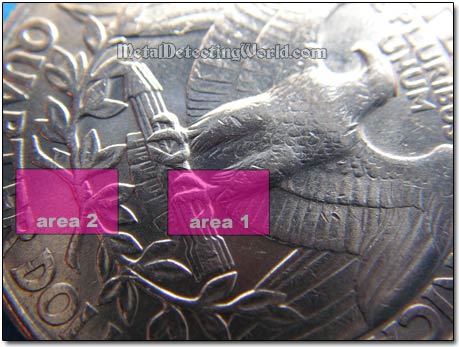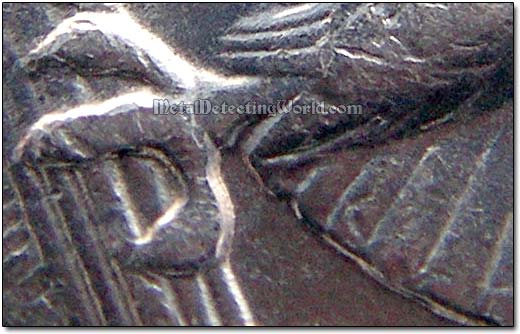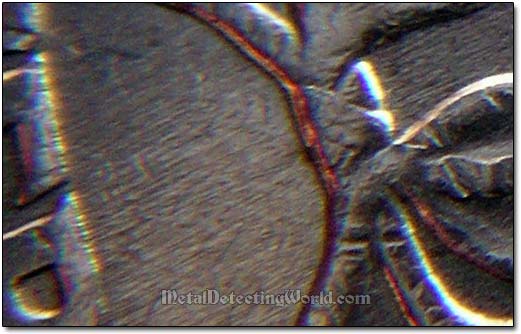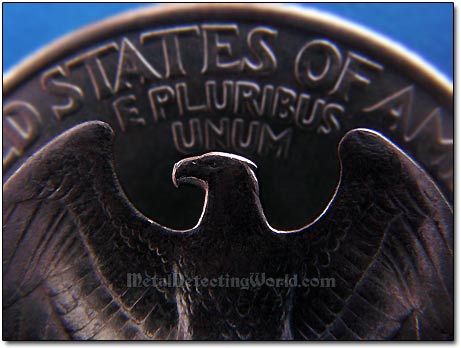How To Clean Coins and Jewelry with Electrolysis - A Detailed Tutorial, page 25
Checking Clad Coin's Well-Preserved Surface for Any Effects of Electrolysis
(...CONTINUED from Previous Page)
Despite the high voltage/amperage settings, the coin does not seem to incur any damage, even if I look at the coin's surface using a magnifying glass.
Two Areas in Focus on Coin Surface

If it was not for many microscopic scratches, the surface looks flawless.
Coin's Surface of Area 1 Up Close

The coin's surface in the second area appears the same: no ugly pitting.
Coin's Surface of Area 2 Up Close

8. Conclusion
Electrolysis is capable to remove anything including coin's patina off the coin's metal surface. That is why not any coin should be subjected to this "aggressive" method of cleaning. While gold coins do not need electrolytic cleaning, and silver coins respond well to "zapping", the dug, badly corroded coins that are made of copper-base alloys do not regain their decent appearance after electrolysis. If a copper coin had suffered irreversible damage by corrosion, removing the resulting layer of verdigris or "bronze disease" encrustation off will only reveal what is left of the coin, and in most cases, that has a very dreadful appearance.
If the copper, bronze or brass coin has reasonably good true patina and is aesthetically pleasing, leave it "as is." The ancient coins should not even be considered for the electrolytic treatment, no matter how hard they are to clean. Theoretically such coins can be cleaned at reasonably low voltage/amperage levels, but the process may take a long while to achieve satisfactory results. This approach requires lots of patience, close attention and competence.
The electrolysis should not be used as a "short cut" that can potentially destroy a valuable coin. Even the 18th-19th century coins will eventually become rare. Any old coin is a piece of history. Electrolysis, if not done right, can ruin the pieces of history that can never be replaced. If one does not have a substantial experience and skills in electrolytic cleaning of the copper-alloyed coins, one should use this method only for cleaning dug modern coins that have well-preserved surfaces.

Happy Electrolytic Coin Cleaning!
Make a Donation
Please help me stay afloat, afford more metal detecting trips with field-tests and experiments to create more informative articles, useful tutorials and helpful guides for detectorists, and maintain this website - the most informative hobby resource on the web! Since I do not have any steady income, any donation matters to me a lot! Thank you kindly!
Clicking on the donate button will take you to a donation page powered by Donorbox and dedicated to my website (MetalDetectingWorld.com). The donation page is PCI-compliant, secured by SSL/TLS, and has a simple form to fill out. Donorbox does not store any card or bank data. Credit card information is encrypted and tokenized by the Stripe payment processor.
This website would not exist without the advertisements we display and your kind donations. If you are unable to support us by viewing our advertisements, please consider making a Donation to ensure the future of this website. By helping me keep this website alive and growing, you will sure help many detectorists around the world as well!
ANNOUNCEMENT:
In January of 2020, I started a one-time fund-raising campaign in attempt to accumulate enough money to buy a simple but reliable 4x4 vehicle. My old 4x4 car (made in 1995) had faithfully served me for 10 years before it eventually went beyond repair last October. Without a 4WD, I will not be able to get to my hunt sites and test-plots hidden in the remote wooded areas inaccessible by a regular car.
Unlucky for me, those sites are the only locations available and suitable for my field-work which results in informative articles you can find on this website. For the past 10 years, my usual field-work has consisted of field-testing the latest metal detectors and accessories, experimenting with some of them, and devising new effective search methods that meet the requirements of the new metal detecting reality.
Before my car died, I managed to finish a couple of interesting detector-testing projects which will be covered in my upcoming articles. But other equally important projects that I was working on were not completed and had to be postponed until the Spring 2020. I hope that this fund-raising campaign will help me get a decent 4x4 by then so that I will be able to resume my work and to write more new articles, tutorials and guides based on data gathered through testing and experimentation.
If you find my website useful and would like it to provide more essential info for you and other detectorists worldwide, please consider chipping in $5, $20, $50 or whatever you can afford to keep MetalDetectingWorld.com growing in 2020. I promise you, it will be money well spent. Thank you.
DonateA Complete Guide to Coin Cleaning
Sources: en.wikipedia.org
- Please help me promote this tutorial:
If you would like to follow me on Twitter, please press a button:
I have my profile page on
where you can share your thoughts on this tutorial, ask me a question, or place a friend request.I also have my profile pages on Pinterest, LinkedIn, Tumblr, Reddit and Delicious
and my "Metal Detecting World" page on Twitter, Pinterest and Tumblr
I no longer maintain my old Facebook page